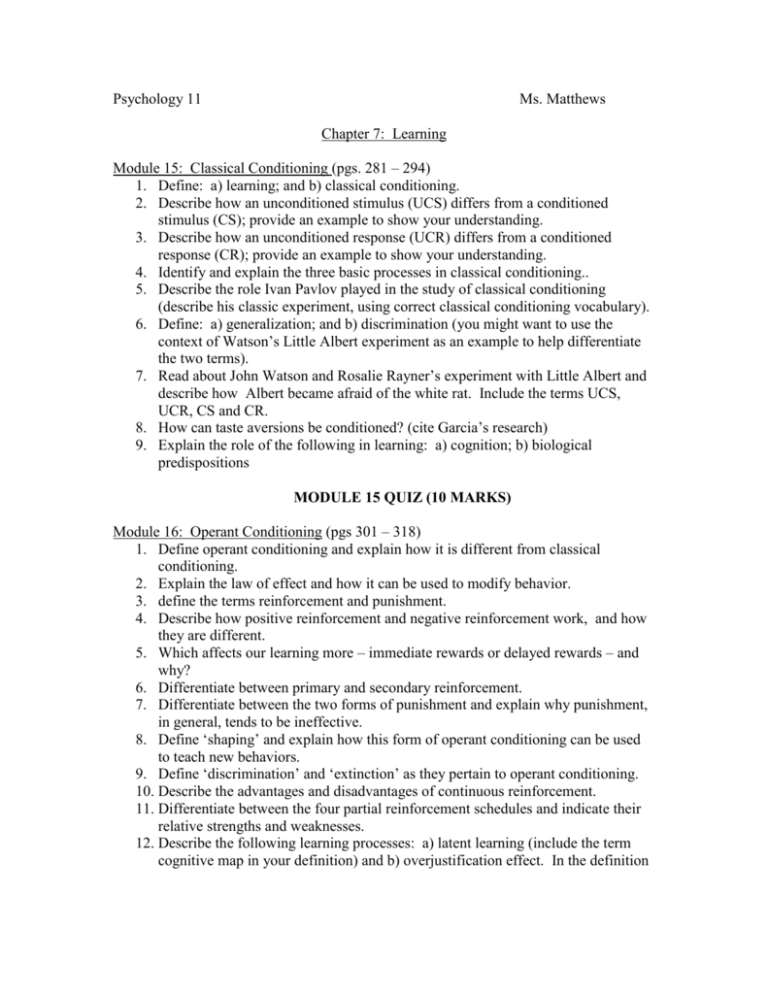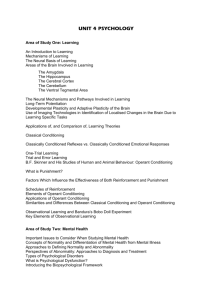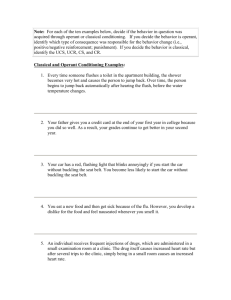Chapter 7, Modules 15
advertisement

Psychology 11 Ms. Matthews Chapter 7: Learning Module 15: Classical Conditioning (pgs. 281 – 294) 1. Define: a) learning; and b) classical conditioning. 2. Describe how an unconditioned stimulus (UCS) differs from a conditioned stimulus (CS); provide an example to show your understanding. 3. Describe how an unconditioned response (UCR) differs from a conditioned response (CR); provide an example to show your understanding. 4. Identify and explain the three basic processes in classical conditioning.. 5. Describe the role Ivan Pavlov played in the study of classical conditioning (describe his classic experiment, using correct classical conditioning vocabulary). 6. Define: a) generalization; and b) discrimination (you might want to use the context of Watson’s Little Albert experiment as an example to help differentiate the two terms). 7. Read about John Watson and Rosalie Rayner’s experiment with Little Albert and describe how Albert became afraid of the white rat. Include the terms UCS, UCR, CS and CR. 8. How can taste aversions be conditioned? (cite Garcia’s research) 9. Explain the role of the following in learning: a) cognition; b) biological predispositions MODULE 15 QUIZ (10 MARKS) Module 16: Operant Conditioning (pgs 301 – 318) 1. Define operant conditioning and explain how it is different from classical conditioning. 2. Explain the law of effect and how it can be used to modify behavior. 3. define the terms reinforcement and punishment. 4. Describe how positive reinforcement and negative reinforcement work, and how they are different. 5. Which affects our learning more – immediate rewards or delayed rewards – and why? 6. Differentiate between primary and secondary reinforcement. 7. Differentiate between the two forms of punishment and explain why punishment, in general, tends to be ineffective. 8. Define ‘shaping’ and explain how this form of operant conditioning can be used to teach new behaviors. 9. Define ‘discrimination’ and ‘extinction’ as they pertain to operant conditioning. 10. Describe the advantages and disadvantages of continuous reinforcement. 11. Differentiate between the four partial reinforcement schedules and indicate their relative strengths and weaknesses. 12. Describe the following learning processes: a) latent learning (include the term cognitive map in your definition) and b) overjustification effect. In the definition of each, be sure to show that in each case, cognitive processes are impacting operant conditioning. 13. How does biological predisposition effect learning? MODULE 16 QUIZ (10 MARKS) Module 17: Observational Learning (pgs 325 – 330) 1. Define ‘observational learning’ and describe how Bandura’s research demonstrated the principles of observational learning. 2. How does observational learning differ from vicarious learning. 3. What four conditions must be met in order for observational learning to occur? 4. Define each of the following terms and outline the role observational learning has in developing such behaviors: a) antisocial behavior; b) prosocial behavior 5. What kind of influence is exerted on us by violence in the media (outline the consequences as they pertain to violence in real life). MODULE 17 QUIZ (10 MARKS) Chapter 7 Unit Test (Date:________________________)









